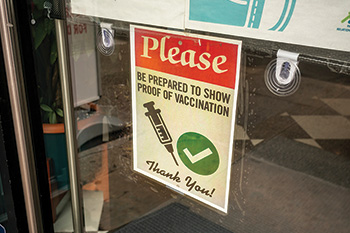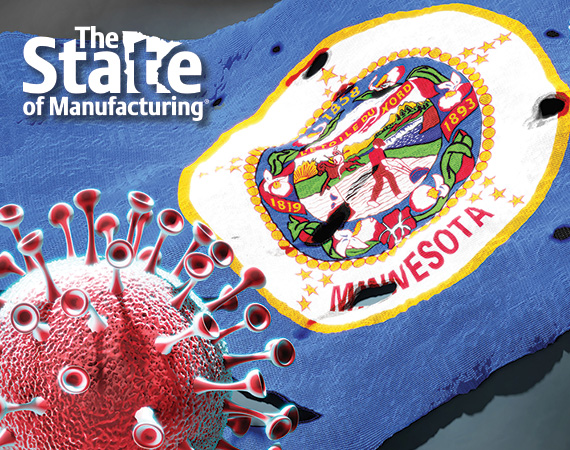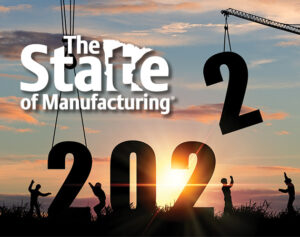Editor’s Note: Enterprise Minnesota conducted 13 focus groups of manufacturers who provided subjective commentary to accompany the objective data found in its State of Manufacturing® survey. Nine were held via Zoom and four in person. What follows is a highly edited transcript of a Zoom focus group conducted Sept. 15. Participants were encouraged to respond under the reassurance that their names and references to any person or company would be kept confidential.
How have mask wearing and mandates become part of your HR apparatus at the office? Have you had an employee say if you make me get a shot, I’m going to work across the street?
“I think there are a lot of people who feel that way. They are vocalizing it.”
“For us, the mask and vaccination issues have become very divisive. Very few of our employees fall on the side of wearing masks. I would say a few others agree the vaccinations are necessary, but a lot of our employees don’t believe they are necessary. If that mandate is carried out, I think it would be a big detriment on our employee base. We’d probably lose quite a few employees.”
“I think the general feeling in our region is that we’re far enough north so people aren’t too concerned with the vaccination mandate. It hasn’t really been much of an issue. At worst, it has been a hassle just dealing with putting up the signs and having all the PPE and all that other stuff in place. But beyond that, I haven’t had any real issues with our employees.”
“We’re a small company. We’re all vaccinated. We’re not really concerned about masks. For us, it hasn’t been an issue. All of us follow the science, so we’re not objectors in any way, shape or form. We’re not wearing masks, but we’re not really concerned about it because everybody’s vaccinated.”
“I don’t know how many employees have been vaccinated. We’re not keeping track, but I suspect a pretty good number aren’t vaccinated. We’ve had a few people who have been in and out with COVID over the past year and a half, but everybody recovered. When things were mandated by the governor, we required masks, but we also required everyone to keep their distance from each other during the greater part of that time. I don’t expect we’re going to be forced to do anything, but it probably would be a problem if we were forced to have employees vaccinated. I think with masks we might be able to work around that. It hasn’t been a problem. We’ve been continuing business as usual.”
“We have about 35 to 40 employees, and we have some who are vaccinated, some who aren’t, and some who have strong opinions on one side or the other. We keep up with the current policies, and we try and educate our workers.”
“We have about 60 full-time employees, and probably 45 to 50 temp employees. I would say that it’s a 50-50 mix with most of our office employees on whether or not they’re vaccinated. During the high COVID time last year, everybody was wearing a mask to comply with the mandate. Right now it’s more don’t ask, don’t tell. If you wear a mask, we assume you’re not vaccinated. No one is really asking questions though. People are very opinionated about this in the community. I anticipate that if we had to comply with everyone getting vaccinated, there would be issues. We have some folks who really want everybody to be vaccinated and some folks who are more on the “how dare you suggest that” side. We’re a CNC machine shop and more of a job shop type business. We’re not producing our own parts. Machinists are very sought after, especially in our area in northern Minnesota. Some of our employees told us that if we do mandate vaccines, they will have no problem finding another job. I think they’re correct.”

“There are some individuals who have asked us if we are going to require a mask. And honestly, I’d say we probably know that 90 to 95 percent of our workforce got vaccinated. So, we’re fortunate there because they asked for help finding the vaccine when it was first coming out. Our HR person helped them find clinics that offered the vaccination. We did have a COVID outbreak here, so we did close in December. I think that prompted many of our employees to get the vaccination because we ended up closing for about five days.”
No one will deny that this has been a weird pandemic-inspired year in terms of the manufacturing economy. As you look at the next year, the next 12 months, what would you say is the biggest challenge that you face as a manufacturer?
“Supply chain security. It’s been difficult just making sure things are available. A lot of our stuff has to be made in America. The sourcing of some of those components and parts has become a little bit more of a challenge. There are other delays that come in that are directly tied to COVID and what COVID has done to certain parts of our supply chain. Our ability to get needed parts has been delayed a bit, but our purchases are not very time sensitive. We’re lucky because our customers and our client base are both very understanding. It hasn’t impeded our business yet.”
“We’re a seasonal company. In the winter months, we haven’t produced as much product, and therefore we don’t need to buy as much inventory. This year, we’re going to have to continue buying the same amount of inventory that we do throughout the summer. We’re going to have a lot of dollars’ worth of supplies just sitting there all winter.”
“There were points during COVID when we were having to ration what we were giving to specific clients. “Well, if you don’t buy this product, we’re not going to be able to give you as much of this product.” I mean, just internally, but it had to be done because we only had so much of everything, and we couldn’t get the containers with our supplies off the ocean. Some of them were circling for four months or longer with products or parts that we needed.”
“One major thing holding us back is finding the skilled employees we’re looking for. I think everybody’s fighting wage increases and the challenge that brings, especially if you do any long-term contract work. That is our biggest challenge. Thankfully in our industry we haven’t been hampered too much other than international shipping. We’ve had a few containers that took four months to get in, but it wasn’t a material shortage. It was just the labor shortage at the port.”

“The only thing I would add is, if you look at tubing, steel tubing, for example, the price has doubled. Our future material costs are uncertain. We’re not only concerned about cost, but also the availability of materials. The bid might be there, but it might not be there when you need it. The result is that, even though you might have more work in progress, you might have to wait for something to finish a project. I think the labor shortage is a problem for everybody. However, I think the material shortage is worse.”
“The material increases are just out of control compared to the last 20 years. We’ve had to review quarterly pricing, where we never used to have to give increases as frequently. We’re looking at doing that right now, due to the lumber and plywood material increases that occurred during the last year. Our clients are not able to get parts, and we are pushing their ship date out. That is impacting our scheduling.”
“Labor is one of our top issues. We’ve also increased our wages by a little over 20% this year, which is more on the low end. On the other side of the coin, we’re competing with McDonald’s. I mean, we’re at the entry level. It’s pushing a button on a machine, and it’s automated. It’s not hard work, but people can find that work anywhere. So, we do struggle. We’ve had issues with third shifts and keeping people on third shifts. We used to run more weekends, and that’s non-existent at this point. We have supply chain issues too.”
“I would say supply chain is our number one issue, as well as employees. Also, just getting the materials we need and just following up with our vendors.”
“Materials are a huge issue — getting the stuff we need. We never used to have a problem getting the components to complete our assembly. We make track systems for industrial lights. Some of the rings we need are American made, and we’re having difficulties with steel. We have issues with stuff coming through the ports, and we’ve had these problems the last six months.”
Even if you did have the materials, would you have enough people to complete those orders?
“That would be another problem, and one that we would have to figure out. I’ve been fortunate to grow our workforce. We’re working with local school boards. They’re trying to bring in STEM-related fields, manufacturing, and they’re trying to get youngsters involved. If they succeed, we should be able to get the people we need for future work. We’re working with colleges, workforce centers, and the state. Everybody is struggling, and I think I’ve been just a bit luckier because we’ve been able to bring on a couple of people. I spent quite a bit of time trying to recruit. I think I’ve done a little more than some folks.”
Is the worker shortage here to stay? Is this problem something that you as manufacturers are going to have to confront every day forevermore?
“I think so. I think we need to start thinking that way. We’re doing a lot to train from within. We’re getting qualified people with no skills, and we’re training them. If we train 10 people, that’s a lot of money. We’re not that big of a business. We have to nip away at it year by year. Our growth rate, as bringing on employees goes, does not match the growth rate potential. That will be a big problem in the long run.”
How much will automation play into your ability to make up productivity efficiencies in view of the fewer employee numbers available?
“We started automating machines every so often, but robots are terribly expensive and that requires a lot of programming, time and energy. But yes, I do think automation is here to stay.”
“I agree. We’re actually right in the middle of spending about $25,000 for a very minuscule automation project. But the reason we have to do that is the shortage of people.”
Last year, one of the most surprising results from our focus groups was the number of people affected by cybersecurity issues. Is that on your radar now?
“I just went through our business insurance renewal. That was an issue our insurance rep mentioned. If we want to be able to go out to market next year, we needed to increase our cybersecurity. We met with our IT company, and we’re going to a whole new level of security. That’s something I never thought we’d have to do.”
“We’re going through it because we are a defense business. We haven’t had any incidents, thankfully, but they can be a big cost drive.”
“We do a cybersecurity annual test. We increased our security last year with passwords, renewals, and expirations, as far as timelines go. We had one incident where an employee’s email was hacked and information was sent out. Our insurance has us go through what our plan is, and we have a policy that has increased in the past few years.”
What about the increasing incidences of things like fake invoices and things like that snaking through your systems? Are you seeing examples of that in your own experience?
“Yeah, all the time there are things like that. I think some of these things are preventable and some are unpreventable. The idea would be to implement a framework so cybersecurity doesn’t become an afterthought. It’s part of our culture. I think the biggest cybersecurity problems are phishing and social engineering attacks. We can educate folks to have a skeptical eye when they’re looking at an email, when they look at a text message.”
What’s your sense of where the economy is going and how it will affect your ability to plan and your profitability?
“I think there are a lot of things going on with the economy, and that becomes somewhat of a geopolitical conversation. I think we’ve seen some challenges and risks, and they are impacting what many of us have come to assume was normal business. That makes us as a group a little bit more wary right now with the state of things. The question is whether it’s going to get worse before it gets better.”
“Our concern is being shut down again. We are retail, so when stores shut down that impacts our business. We are investing in automation, which is something that could offset the labor issue. I think for us, the biggest problem going forward will be the supply chain.”
In the 13 years of doing these focus groups, the number one issue of concern facing manufacturers has always been the same thing, no matter what’s happening in the marketplace — the cost of health care. Is that still an issue? Or is it just a cost of doing business that you can’t do anything about?
“It’s still an issue. We’ve continued to see double digit increases every year. You can’t stay ahead of that without pricing yourself out of the market. It’s impacting our margins and our strategies. That’s another reason to push for more automation. The robots don’t need much insurance.”
“I’m just waiting every year for the cost of health care to go down, but it just never happens.”
…
Featured story in the Winter 2021 issue of Enterprise Minnesota magazine.


